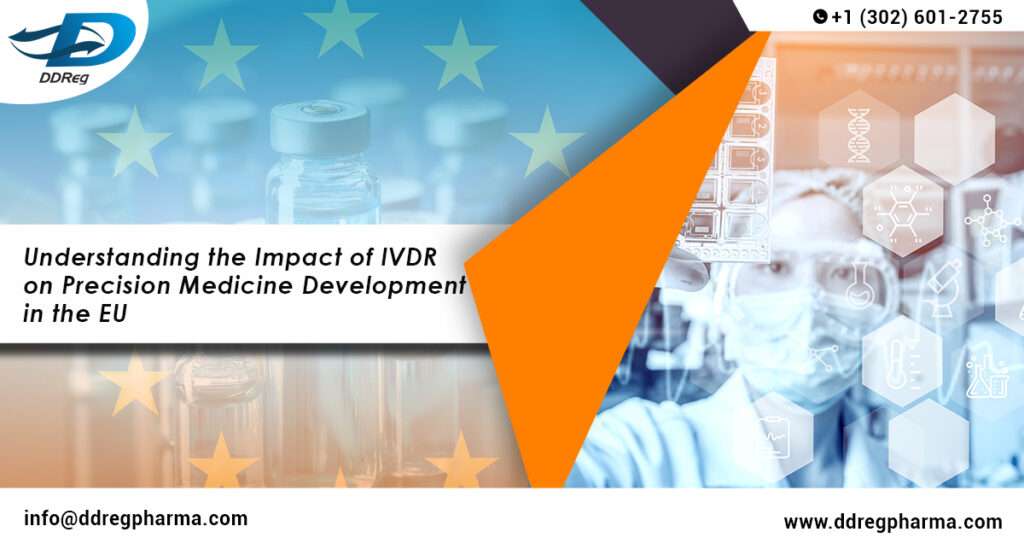The European Union introduced the In Vitro Diagnostic Regulation (IVDR), an elaborate regulatory framework intended to increase safety, performance and reliability of in vitro diagnostic (IVD) medical devices. Replacing its predecessor (IVDD), EU IVDR requires stricter requirements for compliance while placing greater emphasis on clinical evidence, risk classification and post market surveillance. Precision medicine, an innovative approach to healthcare, customizes treatments based on individual patient characteristics. To do so, precision medicine relies heavily on advanced diagnostics that detect biomarkers and genetic predispositions, using IVDR’s revision of regulatory pathways as key enablers of personalized therapy strategies. Let’s delve into the impact of IVDR in EU, how medical development and Regulatory Compliance transform after revision on IVDR.
Redefining Regulatory Standards for In Vitro Diagnostics
The IVDR replaced IVDD and brought about significant shifts to in vitro diagnostic regulations, particularly regarding compliance measures aimed at assuring higher standards of safety and performance for diagnostic products. Gone is self-certification model in favor of rigorous evaluation by Notified Bodies that enhance oversight but may lengthen approval timelines.
IVDR places greater emphasis on clinical evidence and analytical performance. As per this regulation, manufacturers are now required to present scientific proof proving safety, accuracy, and reliability of diagnostic tests; while such measures improve patient safety, they do present new challenges to diagnostic developers in terms of data collection as well as regulatory submission.
Companion Diagnostics Under IVDR
Companion diagnostics (CDx) plays an essential part in precision medicine by helping identify patients eligible for targeted therapies. Under IVDR’s requirements for CDx use, which require rigorous validation procedures and extensive performance data to ensure clinical accuracy, companion diagnostics have become even more essential to medical practice.
Pharmaceutical companies must now closely align their drug development processes with IVDR-approved diagnostics. This alignment is critical for market access, as drugs dependent on specific biomarkers require validated CDx tests. The heightened oversight ensures the reliability of diagnostic tools but also increases the complexity of regulatory submissions, necessitating stronger collaboration between diagnostic and pharmaceutical firms.
The Compliance Bottleneck for Precision Medicine Developers
IVDR introduces several compliance challenges that impact precision medicine developers. These include:
- Risk Classification: A new risk-based classification system redefines IVD categories, placing a majority under stricter Notified Body scrutiny.
- Clinical Performance Studies: IVDR mandates robust clinical performance studies to validate diagnostic effectiveness, increasing the time and cost of regulatory approval.
- Post-Market Surveillance: Continuous monitoring and reporting requirements demand long-term compliance efforts.
Notified Bodies, now responsible for certifying a larger share of diagnostics, face capacity constraints, leading to extended approval timelines. This poses a significant challenge for small and mid-sized diagnostic firms, which may lack the resources to navigate the complex regulatory landscape efficiently.
Market Access Delays
IVDR regulations have led to an unexpected slowdown in new diagnostic approvals and innovation within precision medicine, with biomarker discovery and genomic testing becoming more time consuming due to regulatory bottlenecks; consequently, delaying market entry of cutting-edge diagnostic tools.
Industry stakeholders have responded by taking proactive steps such as engaging early with regulatory authorities and including strategic regulatory planning in development pipelines, to avoid delays caused by regulatory authorities and expedite approval processes – helping companies anticipate compliance hurdles more easily while expediting approval processes, thus guaranteeing continued innovation within precision medicine.
Transforming Regulatory Compliance into a Competitive Edge
Compliance with IVDR can be leveraged as a competitive edge despite its challenges. Sophisticated regulatory strategies build credibility, providing more straightforward market access and building trust among healthcare providers and patients.
Companies looking to expedite submissions have increasingly turned to Regulatory Information Management Systems (RIMS) for efficient documentation and compliance tracking, while Real-World Evidence and AI-powered diagnostics are becoming a crucial element of IVDR compliance by providing insights into diagnostic performance as well as supporting regulatory decision-making processes.
Conclusion
Although IVDR presents regulatory challenges, it also serves as a catalyst for precision medicine innovation. Preliminary planning and strong collaboration among pharmaceutical and diagnostic firms is vital in meeting compliance challenges quickly and ensuring timely market access.
By taking an approach of strategic regulatory planning, technology-based compliance solutions, and industry collaboration, stakeholders can effectively navigate IVDR – ultimately benefitting patients through quicker access to lifesaving precision medicine treatments.
Reach out to DDReg for expert regulatory services and tailored solutions for medical device registration in global markets. Read more about medical devices and diagnostics landscape in EU: Navigating EU Classification Standards for AI in Medical Devices and Diagnostics

